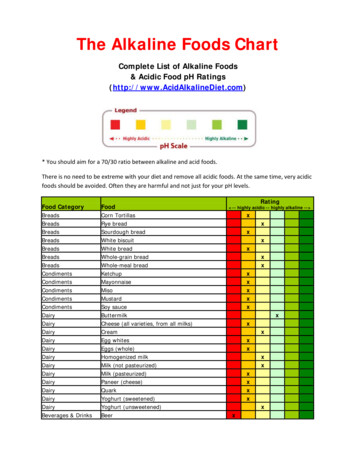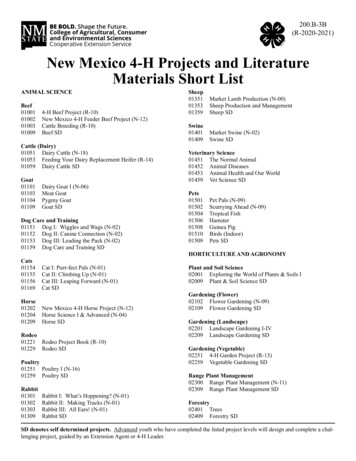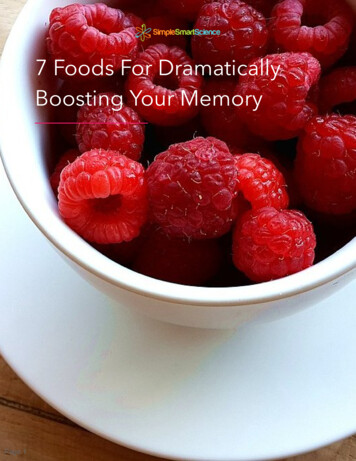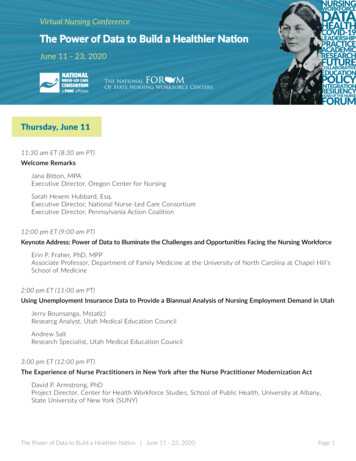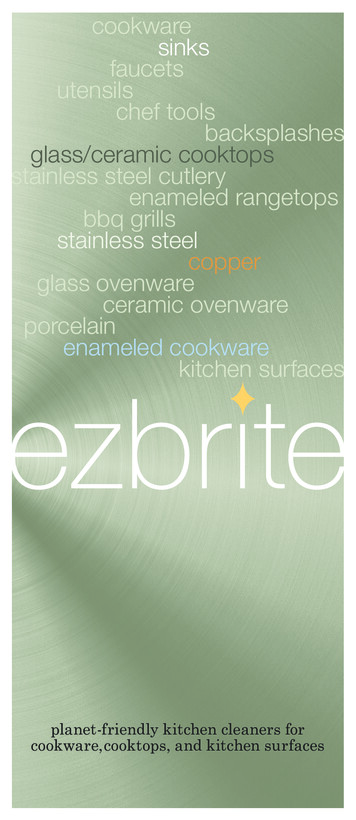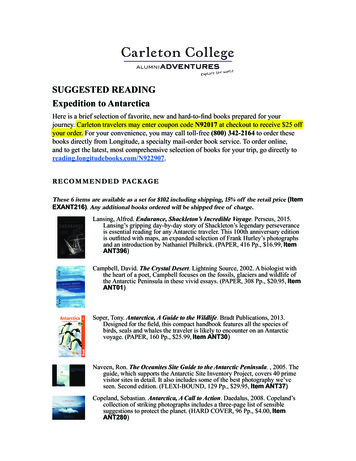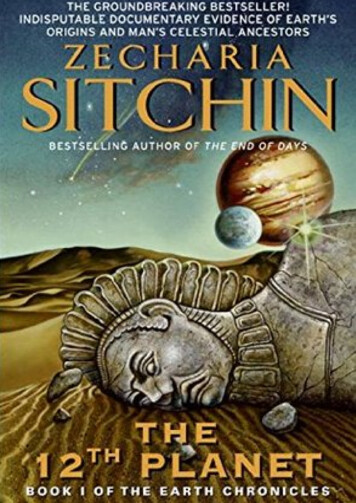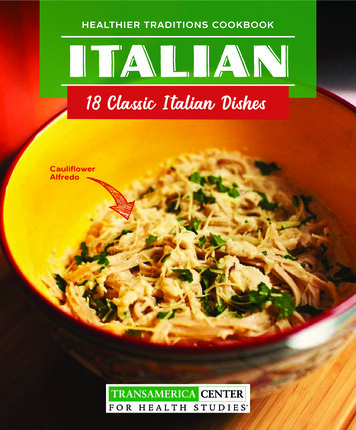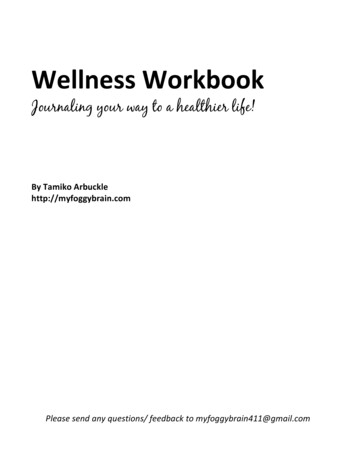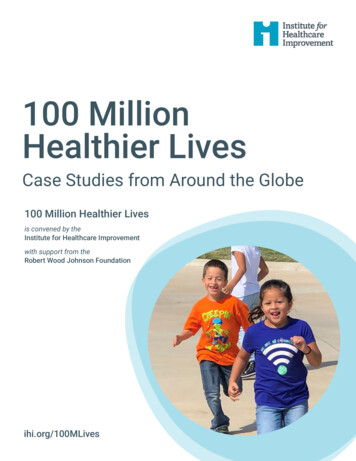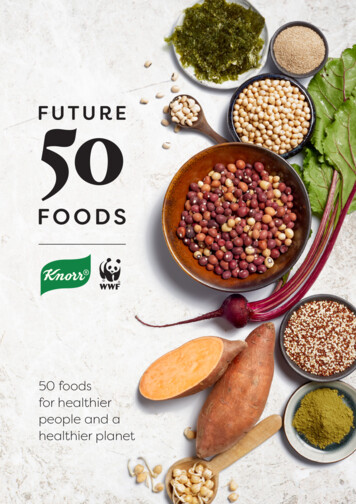
Transcription
50 foodsfor healthierpeople and ahealthier planet
FUTURE 50 FOODS
50 FOODS FOR HEALTHIER PEOPLE AND A HEALTHIER PLANET“Most of us might believe it’sour energy or transport choicesthat cause the most seriousenvironmental damage. In fact,it’s our food system that createsthe biggest impact.”Dr. Tony Juniper, CBE,Executive Director for Advocacy, WWF-UKOUR WORLD IS FACING ANUNPRECEDENTED CHALLENGEBy 2050 the world population is predicted toincrease to almost ten billion people whom we mustnourish on a planet of finite resources. It is welldocumented that to do this we need to transformour global food system – from the way we farmand fish to what we choose to eat. It is a complextask, and if we are to deliver nutritious food to all,everyone needs to play a part in making the foodsystem more sustainable. Large scale, practicalsolutions are essential to make the required changes.Globally we rely on a small range of foods. Thisnegatively impacts our health and the health ofthe planet. Seventy-five percent of the global foodsupply comes from only 12 plant and five animalspecies. Just three (rice, maize, wheat) make upnearly 60 percent of calories from plants in theentire human diet1. This excludes many valuablesources of nutrition. While people may be gettingsufficient calories, these narrow diets don’t provideenough vitamins and minerals.Dietary monotony is linked to a decline in thediversity of plants and animals used in andaround agriculture (agrobiodiversity), threateningthe resilience of our food system and limiting thebreadth of food we can eat. Since 1900,a staggering 75 percent of the genetic plantdiversity in agriculture has been lost2. In mostAsian countries, the number of rice types grownhas decreased rapidly from thousands to a dozen.In Thailand, for example, the 16,000 varieties oncecultivated have dropped to just 37 varieties3. Inthe past century, the United States has lost 80percent of its cabbage, pea and tomato varieties.This dependence on a limited pool of crop speciesleaves harvests vulnerable to pests, diseases andthe impact of climate change.Farming a narrow range of crops using intensivemethods can have serious repercussions on ourfragile natural ecosystems. Monoculture farming,which is the repeated harvesting of a single crop,and over-reliance on animal-based foods arethreatening food security. Monoculture farmingcan deplete nutrients and leave soil vulnerable tothe build-up of pests and pathogens. This requiresapplications of fertilisers and pesticides that can,if used inappropriately, damage wildlife andleach into water systems4, 5. Many types of birds,animals and wild plants cannot thrive in biologicallydegraded landscapes.Reliance on animal-based protein sources putsadditional strain on our environment and currentagricultural practices are not sustainable in thelong term. Total agriculture accounts for arounda quarter of all greenhouse gas emissions, ofwhich approximately 60 percent is due to animalagriculture6. Meat, dairy and egg production is morewater, land and greenhouse gas intensive thanplant production. It also contributes to pollutionthrough liquid waste discharged into rivers and seas.These problems seem insurmountable, but webelieve that large scale change starts withsmall actions.EATING TO IMPROVETHE FOOD SYSTEM“Diversified diets not onlyimprove human health butbenefit the environment throughdiversified production systemsthat encourage wildlife and moresustainable use of resources.”Peter Gregory, Research Advisor,Crops For the Future3
FUTURE 50 FOODSKnorr and WWF have a shared ambition to drivechange, which is why we, in partnership withDr. Adam Drewnowski, Director of The Centerfor Public Health Nutrition at the Universityof Washington, have collaborated to createThe Future 50 Foods Report.In a world cluttered with advice and pressurearound what not to eat, we want to providepeople with more food choices to empowerpositive change. For this reason, we haveidentified 50 foods we should eat more ofbecause they are nutritious, have a lower impacton our planet than animal-based foods, can beaffordable, accessible and taste good.“By joining together with ourpartners, we believe we canshift the way food is grown andthe foods people choose to eat,delivering significant, positiveimpact on the food system.Our mission is simple: makedelicious, nutritious,and sustainable foodaccessible to all.”April Redmond,Global Vice President, KnorrThe list of Future 50 Foods, consisting ofvegetables, grains, cereals, seeds, legumesand nuts from across the globe, has beendeveloped to inspire greater variety in whatwe cook and eat. It is intended to enable threeimportant dietary shifts. First, a greater varietyof vegetables to increase intake of vitamins,minerals and antioxidants. Second, plant-basedsources of protein to replace meat, poultry andfish, resulting in reduced negative impact on ourenvironment. Third, more nutrient-rich sources ofcarbohydrates to promote agrobiodiversity andprovide more nutrients.4Not all 50 foods are currently easily accessible.Working together with partners allows us tomake these foods more commonly grown andmore widely eaten.By making a conscious choice to consumemore of the Future 50 Foods, we take a crucialstep towards improving the global foodsystem. Swapping staples like maize and whiterice for fonio or spelt increases the nutrientcontent of a dish while contributing to greateragrobiodiversity, making our food supply moreresilient. It also helps safeguard these ancientvariants for future generations.“The search for nutrient-denseplants has taken us towardancient grains, heirloom plantvarieties, and less commonlycultivated crops. There is a goodreason for rediscovering some ofthe forgotten plants.”Dr. Adam Drewnowski,Director of The Center forPublic Health Nutrition,University of WashingtonThese 50 foods are some of the manythat we can and should eat. According tothe Food and Agriculture Organization of the UnitedNations (FAO), there are between 20,000 and50,000 discovered edible plant species, of whichonly 150 to 200 are regularly consumed by humans7.Future 50 Foods is the beginning of a journey and away for people to make a change, one delicious dishat a time.
50 FOODS FOR HEALTHIER PEOPLE AND A HEALTHIER PLANETCRITERIA FOR THE FUTURE 50 FOODSThe Future 50 Foods have been selected based on their highnutritional value, relative environmental impact, flavour, accessibility,acceptability and affordability. This set of criteria is modelled after theFood and Agricultural Organization’s (FAO) definition of sustainablediets. Some of the Future 50 Foods have higher yields than similarcrops, several are tolerant of challenging weather and environmentalconditions, and many contain significant amounts of critical nutrients.Each has a story to tell.See the full methodology at the end of the report.‘‘The discovery of a new dish does morefor the happiness of the human racethan the discovery of a star.As famously said by French gastronome,Jean Anthelme Brillat-Savarin5
FUTURE 50 FOODS ISTHE BEGINNING OF AJOURNEY AND A WAYFOR PEOPLE TO MAKE ACHANGE, ONE DELICIOUSDISH AT A TIME.
Algae are nutrient-rich and critical to our existence onthe planet. They are responsible for half of all oxygenproduction on Earth and all aquatic ecosystems dependon them. They contain essential fatty acids and are anexcellent source of antioxidants. Algae can be rich inprotein and have a meat-like umami flavour, making thema potential replacement for meat8, 9.
FUTURE 50 FOODSCategory1AlgaeLaver seaweedPorphyra umbilicalisLaver is a variety of red algae known for its link to Japanese cuisine. Called ‘nori’ inJapan and most commonly used for wrapping sushi, laver is heralded for itsexceptional nutrient content and ability to bring out the umami flavour in foods.Umami is the flavour profile that meat provides and is commonly missed inplant-based dishes.Edible seaweed cultivation has been suggested to be a gamechanger10 in the food system. Because it lives wildly in the water, laverseaweed can be grown and harvested throughout the year anddoes not require pesticides or fertilisers. Laver seaweed is rich invitamin C and iodine11.Laver is often consumed dried as a topping for soups and salads. InKorea, it is eaten dried as a savoury snack and is referred to as ‘gim’.In the UK, especially in Wales, laver is used to make laverbread,a dish in which the fresh seaweed is slow-cooked, seasoned andtraditionally served with hot, buttered toast. Some say people inWales have been eating laver since the first inhabitants arrived;others say it was introduced by the Vikings.8
50 FOODS FOR HEALTHIER PEOPLE AND A HEALTHIER PLANETCategory2AlgaeWakame seaweedUndaria pinnatifidaCultivated for centuries by sea farmers in Koreaand Japan, deep-green coloured wakame isrich in nutrients and easy to grow. Maintainingsimilar properties to other seaweeds, it can beharvested all year round, grows rapidly withoutthe use of fertilisers or pesticides and supportsthe water’s biological balance. Beyond Asia, itis farmed in sea fields in France, New Zealand,California and Argentina.In addition to containing a variety of vitaminsand minerals, wakame is one of the fewplant-based sources of the omega 3 fatty acidEPA (eicosapentaenoic acid), which is foundalmost exclusively in fatty fish that feed onalgae12. Most commonly sold dried and thenrehydrated, wakame has a savoury flavourand satin-like texture. It can be choppedand added to soups or fried and thrown intosalads, stir-fries, and side dishesfor a salty, umami flavour.9
“We work with hundreds of thousands ofsmallholder farmers in many countries in subSaharan Africa to garner the benefits of nitrogenfixing grain legumes. It’s no surprise that manylegumes made it onto the Future 50 Foods list.”Professor Ken Giller, Wageningen University, N2AfricaN2Africa is a research-in-development projectfocused on putting nitrogen-fixing to workon smallholder farms in sub-Saharan Africa13
Beans and other pulses are members of the legumefamily. They can convert nitrogen from the air and ‘fix’ itinto a form that can be readily used by plants. More thanenvironmental superheroes, beans offer us a rich sourceof fibre, protein and B vitamins. They are eaten in manydishes all over the world and have a mild flavour andmeat-like texture, making them a sensible swap for meatin stews, soups and sauces.
FUTURE 50 FOODSCategory3Adzuki beansVigna angularisAdzuki beans are rising in popularity due totheir versatility, nutritional content and flavour.Small and brownish-red, they are the nutrientrich fruit of drought-tolerant plants, meaningthey require less water than many other cropsand can produce high yields, even on dry land.They are commonly enjoyed in Japan andother parts of Asia, thanks to their mild andsweet, slightly nutty taste and reputed healthbenefits. They are full of antioxidants14 and4Adzuki beans are often cooked, puréed andsweetened to make a paste that can be usedas a filling in sweet treats, added to soups andmixed with rice as a tasty side dish. They arealso great in salads and stir-fries.Phaseolus vulgarisParticularly popular in Latin American cooking,black beans are small and shiny with a subtlysweet, mushroom-like flavour. Their dense,meaty texture makes them perfect for stewsand curries, or as a substitute for ground beefin any dish.They are often combined with grains likebrown rice or quinoa, seasoned with onions,garlic and spices and served as a side dish,or topped with vegetables for a full meal.Whether bought canned or dried, the waterused to store or cook the beans can be addedto dishes for extra earthy flavour.Broad beans (fava beans)Vicia fabaWhen in bloom, the sweet-scented flowers ofthe broad bean plant call to honeybees – thevital pollinators responsible for one in threemouthfuls of food. Broad beans also functionas a cover crop, grown between harvests toprotect the land. Cover crops help supressweeds, enrich the soil and control pests. Thesehardy and adaptable plants can grow in mostsoils and climates.12packed with protein. They also contain highlevels of potassium, B vitamins and fibre.Black turtle beansThese powerhouses of the legume family areregularly listed as ‘superfoods’ due to their highprotein and fibre content.5Beans & PulsesThe beautiful green beans have a sweet,grassy taste and buttery texture. They areprotected by a pod that can be eaten rawwhen the plant is young. As the plant ages, thepod hardens and is not commonly consumeddue to its texture and bitter flavour. They makea nice protein and fibre-packed addition torisottos, soups and stews. They are also greatas a side dish seasoned with rosemary, thymeand pepper.
50 FOODS FOR HEALTHIER PEOPLE AND A HEALTHIER PLANETCategory6Beans & PulsesBambara groundnuts/Bambara beansVigna subterraneaAlthough not a commonly known crop in many parts of the world, Bambara groundnutsare the third most important legume in Africa, after peanuts and cowpeas. It is alegume but tastes like, and is eaten like, a nut. It has gained interest amongstmany sustainable food experts because it is an underutilised, nutritious cropthat can grow in challenging environments, even in highly acidic soils.Local African names for Bambara groundnuts include jugo beans, ditloomarapo, indlubu, hlanga, njugo, nduhu, phonda, and tindhluwa.The name Bambara groundnut originates from the Bambara tribe thatlives throughout Mali, Burkina Faso, Guinea and Senegal. They aregrown mainly across these regions in sub-Saharan Africa andmore scarcely in South Africa. They are also cultivated acrossSoutheast Asia, primarily in southern Thailand, West Java andparts of Malaysia15, 16.Growing Bambara groundnuts has many advantages, makingthem a model sustainable crop. It has nitrogen-fixing nodules,which means the roots fix nitrogen from the air which the plant usesas a fertiliser to produce the nutritious bean. Some of the nitrogenis returned to the soil, thereby improving fertility and helping boostyields when intercropped with other plants. In Malaysia, Bambaragroundnuts are grown to support the growth of delicate young treeson its rubber plantations.Bambara groundnuts also boast an impressive nutrient profile, fromthe perspective of both the farmer and the consumer, with their uniquecombination of carbohydrates, protein, fibre and many vitamins andminerals. They have less fat than peanuts, allowing them to have a higherconcentration of nutrients per calorie. Compared with other legumes they havea high amount of the essential amino acid methionine. The Bambara groundnut isconsidered ‘complete food’ because of the balance of macronutrients accompanied bythe amino acid and fatty acid content.Bambara groundnuts can be boiled, roasted, fried or milled into a fine flour. The pods are hard and need tobe cracked open to get the edible seed. They are often boiled to make them easier to open and the seeds areeaten as snacks, either plain or with a seasoning. In East Africa the beans are roasted and puréed to be usedas a base for soups. Their flavour is similar to peanuts but a bit sweeter and not as oily17. This versatile, resilientlegume deserves to take a prime spot on your plate.13
FUTURE 50 FOODSCategory7Beans & PulsesCowpeasVigna unguiculataThere are many types of cowpeas; some are more commonly eaten than others.Catjang cowpeas are a less common variety. They are native to Africa but now growin warm regions around the world, including Latin America, Southeast Asia and thesouthern part of the United States. Commonly cultivated for their nutty tasteand high nutritional value, the seeds are little energy powerhouses packedwith minerals and vitamins, including folate and magnesium.Protein-packed cowpeas are a quick-growing cover crop and aredrought hardy and heat-tolerant. They are also a strong nitrogen-fixer,capable of thriving in poor soils and self-seeding18. Cowpeas are alsoable to withstand grazing pressures from livestock.Cowpeas make a hearty, thick soup while their leaves can beenjoyed in the same ways as other leafy greens. The pods canalso be eaten when young and are used in stews. With their outercoating removed, the seeds can also be ground into flour and usedto make deep-fried or steamed patties. In Senegal, Ghana andBenin, the flour is used in crackers and other baked goods.14
50 FOODS FOR HEALTHIER PEOPLE AND A HEALTHIER PLANETCategory8LentilsLens culinarisOriginally from North Africa and Asia, thiscousin of the pea was one of the world’s firstcultivated crops. Requiring little water to grow,lentils have a carbon footprint 43 times lowerthan that of beef19.There are dozens of varieties, all with slightlydifferent earthy, peppery or sweet flavours.Lentils are packed with protein, fibre andcarbohydrates. Puy lentils keep their shape9and texture after cooking and are often servedwith fish or roasted vegetables. Red andyellow lentils dissolve into a rich purée and aredelicious mixed into stews, curries and soups.They are also used to make veggie burgers. Alllentils are simple to cook; pre-soak if necessary,then boil in water or stock/broth (three to oneratio of water to lentils) for 15 to 20 minutesfor whole lentils and five to seven minutes forsplit lentils.Marama beansTylosema esculentumNative to the Kalahari Desert in southernAfrica, marama beans and their edibletuberous roots are drought-tolerant andadapt well to harsh environments anddamaged soils. They are thought to be anancient food, eaten for as long as people havebeen in southern Africa and are now beingsuccessfully cultivated in Australia and the US.10Beans & PulsesTheir oil, which is a good source of essentialfatty acids, can be used for cooking as wellas a dressing. Marama beans themselves canbe boiled or ground into flour. They can alsobe used to make a milk drink. When roasted,they taste similar to cashews, making them agreat addition to stir-fries, curries and othercooked dishes.Mung beansVigna radiataOriginally from Southeast Asia, mung beanswere first grown in the US in the 19th centuryas livestock feed. Today, these tiny, tenderbeans are prized by people in Asia and beyondfor their crisp, clean taste and ability to absorbflavours. They also contain protein, B vitaminsand various minerals.Mung beans are great with noodles, ricedishes, curries and stir-fries. They can even bescrambled like eggs or puréed to resemble icecream. Their sprouts are nutritious too, addingcrunch to salads and sandwiches with theirsweet but earthy flavour.Natural nitrogen-fixers, the plants thrive insunny conditions and are considered heatand drought-tolerant.15
FUTURE 50 FOODSCategory11Beans & PulsesSoy beansGlycine maxSoy (soya) is a pivotal part of the world’s food system. High in protein, soy has transcendedits Asian origins to become the most widely grown legume across the globe. Cultivatedfor well over 9,000 years, soy was regarded by the ancient Chinese as a necessityfor life. It was eaten as a source of protein and crushed for its oil, which nowaccounts for a large proportion of global vegetable oil consumption.Soy’s nutritional value makes it an undoubtedly powerful food. Raw soybeans contain 38 grams of protein per 100 grams20, which is similar topork and three times more than an egg. In fact, soy – which deliversmore protein per hectare than any other crop – also contains vitaminK and B in addition to significant amounts of iron, manganese,phosphorus, copper, potassium, magnesium, zinc, selenium andcalcium. Nutrient-packed soy comes in a variety of products andformats including tofu, soy milk, miso, tempeh and edamame.Despite its versatility and nutritional value, three-quarters of allsoy produced is not for human consumption, but rather for animalfeed21. It takes a high volume of soy as animal feed to produceonly a small amount of meat, which highlights the inefficiency inthe food system. Poultry is the number one livestock sector thatconsumes soy beans followed by pork, dairy and beef22.The current and predicted steady increase in meat consumption posesmajor challenges to sustainable soy production. Cultivation of soy maydrive deforestation, damaging natural ecosystems such as the Amazon,Cerrado and Chaco – home to spectacular wildlife like jaguars, giantanteaters and armadillos.Progress is being made. The negative impact of soy production has been slowedby collaborative market initiatives like the Amazon Soy Moratorium, reducing soydriven deforestation levels in the Amazon rainforest to almost zero. Unilever, Knorr’sparent company, is actively working with other industries and NGO stakeholders to call fora halt in conversion of the Cerrado. Unilever is leading by example by buying sustainably certifiedsoy oil for their products, such as Hellmann’s mayonnaise, and byactively promoting sustainable sourcing standards.Ultimately, lowering the demand for soy as animal feed isa critical lever for reducing the deforestation caused by soyproduction. Shifting to more plant-based foods, including soy,will help to reduce the demand for soy as animal feed, takingpressure off fragile ecosystems, while increasing availability ofnutritious sources of protein.16
While often used as decorative plants in homes aroundthe world, many species of cacti are cultivated forconsumption. Also known as succulents, cacti store water,which allows them to grow in arid climates and toleratedrought. They also contain substantial amounts of vitaminsC and E, carotenoids, fibre and amino acids. Edible cactihave long been a part of Mexican cuisine and the deliciousyoung stem segments, usually called nopales, are the partmost commonly used in recipes.
FUTURE 50 FOODSCategory12NopalesOpuntiaAlso known as the prickly pear or cactus pear,nopales are easy to grow and highly adaptive.They are widely cultivated in Central andSouth America, Africa and the Middle East,and are beginning to increase in popularity inAustralia and Europe.The fruit, flower, cladodes (flattened shootsrising from the stem of the plant) and oil ofthe nopal cactus are rich sources of nutrients,but they are not only valuable crops from anutrition perspective. They also have potentialfor use as an alternative animal feed and toproduce biogas23 (a renewable energy source).18CactiSome clinical studies suggest that nopalescan even help with weight loss,24 due to theirlow calorie and high fibre content, but thebenefits are yet to be proven. They have alsoundergone trials with results suggesting thatthey could help relieve symptoms of alchoholinduced hangovers25. This is likely due to theirnutrient and water content.Nopales are a common ingredient in Mexicancuisine; the leaves and flowers can be eatenraw, cooked, or made into delicious juicesor jams.
“Demand for a wider variety of crops could providemore farmers in developing countries with a boostin income. If handled carefully, with safeguardsagainst potential environmental, social andeconomic risks, it could mean they can send theirchildren to school instead of to work, can investin the farm and become more financially secure the whole local economy could benefit.”Sabita Banerji, Oxfam GB
Cereals and grains are considered the most importantsource of food for human consumption26. They havebeen the principal component of diets for thousands ofyears and, therefore, have played a vital role in shapinghuman civilisation27. For both environmental and healthreasons, there is a pressing need to vary the types ofcereals and grains grown and eaten. Diversifying sourcesof carbohydrates from white rice, maize, wheat and otherstaples, to these less common, whole cereals and grainswill provide more nutritional value and help improve soilhealth. Many of them are readily available whilst othersneed to be brought back into the food system. Demandfor, and supply of, a variety of less common crops needsto be carefully and sustainably increased to help improvediets and agricultural biodiversity.
FUTURE 50 FOODSCategory13AmaranthAmaranthusAmaranth is grown for both its seeds andleaves. The fibre-rich grain is prepared inboiling water, like rice, or popped like corn.Its leaves are a staple food in Asia and Africaand are eaten in the same ways as otherleafy green vegetables.The plant that the amaranth seed comesfrom can be grown at any elevation withoutneeding a lot of water, making it an idealcrop in areas where water is scarce.1421Believed to have been first cultivated inMexico, amaranth is one of the oldest crops,beloved by the Aztecs and Incas for itssuspected supernatural properties.Relative to other grains, amaranth’s sandyyellow seed is high in magnesium andprotein. It has a mild, slightly nutty taste andgelatinous texture making it ideal for soups,side dishes and risottos.BuckwheatFagopyrum esculentumBuckwheat is one of the healthiest, nuttiestand most versatile grains. It is a short seasoncrop, maturing in just eight to twelve weeks,and grows well in both acidic and underfertilised soils. It can also be used as a ‘covercrop’ or ‘smother crop’ to help keep weedsdown and reduce soil erosion while fieldsrest during crop rotation.15Cereals & GrainsContrary to its name, buckwheat is not relatedto wheat and is gluten-free. It is an idealhigher protein swap for flour in pastas andbreads. It can also be a great alternative torice, is ideal cooked in a broth or stock, andcan be used in salads or stuffing. It is popularin Russia and Eastern European countries andis commonly eaten in stews, such as ‘goulash’,with potatoes, vegetables and meat.Finger milletEleusine coracanaFinger millet is a cereal that has beencultivated for thousands of years since it wasfirst domesticated from the wild subspeciesin the highlands that range from Uganda toEthiopia. A member of the grass family, it isnow farmed more widely in the arid regionsof Africa and South Asia as a staple cereal28.fertility and can be intercropped with maize,sorghum and legumes. It has a higher naturalresistance to insects than similar crops, leadingto higher yields with less dependence onpesticide use. Of all major cereals, millet is oneof the most nutritious. It is a good source offibre and vitamin B1 and is rich in minerals.Although the diverse group of crops knownas millets is among one of the most consumed,finger millet is often overlooked by the world atlarge as it only makes up around ten percentof global millet production. As a crop, it hasmany benefits. It can thrive in soils of lowFinger millet is most commonly eaten andused in the same way as other grains orcereals. It can be eaten as porridge, or milledinto flour and used in bread or pancakes. It hasa mild flavour that’s slightly nuttier than quinoaand has a similar texture to couscous.
50 FOODS FOR HEALTHIER PEOPLE AND A HEALTHIER PLANETCategory16Cereals & GrainsFonioDigitaria exilisArguably Africa’s oldest cultivated cereal, fonio is a grain known for its nutty, delicatetaste and versatility. The Bambara people of Mali have a saying that ‘fonio neverembarrasses the cook’ as it is so easy to prepare and can be used in dishes toreplace any grain.Fonio has been around for more than 5,000 years. Evidence shows it wascultivated in ancient Egypt; today it is mainly grown in the dry Sahel regionof West Africa. There are two cultivated species: Digitaria exilis, whitefonio, and Digitaria iburua, black fonio.Fonio is drought-resistant and has the ability to grow in sandy oracidic soil. Its roots help to secure topsoil to prevent the spread ofdeserts and it’s one of the world’s fastest-maturing grains, growingin 60 to 70 days. Fonio is nicknamed the ‘lazy farmer’s crop’because it is so easy to grow. Farmers simply scatter the seeds afterthe first rain and wait for harvest. This traditional method yieldsabout 0.5 to 1.2 tonnes per hectare. However, up to two tonnes perhectare can be harvested under very good agronomic conditions.The main challenge when cultivating fonio is turning the grain intofood. Fonio grains are as tiny as sand and each must have theirinedible covers removed. Farmers spend large amounts of timethreshing and dehulling, most of which is still done manually.Current annual fonio production is estimated at 600,000 tonnesglobally, of which more than 95 percent is consumed within foniogrowing communities.To reduce the manual labour and increase processing capacity, a companycalled Yolélé Foods is building the world’s first fonio mill. The company, which wasco-founded by Pierre Thiam, who is seen as a leading authority on African food inthe United States, currently exports fonio to the United States and Canada. Once themill is finalised in late 2020 in Senegal, the company plans to begin fonio exportation toother parts of the world.Fonio is gluten-free and highly nutritious, containing iron, zinc, magnesium and phytonutrients. Fonio can beused in salads, crackers, pastas, and even in baked goods. It can be used in place of oats to make hot cereal,in place of couscous or rice in any dish and is delicious mixed with spices and olive oil as a side dish. It also canbe used to brew beer.22
FUTURE 50 FOODSCategory17Khorasan wheatTriticum turanicumKhorasan wheat is grown in 40 countriesaround the world and is known for its abilityto tolerate different climates without the useof artificial pesticides or fertilisers. Commonlyreferred to by its trademarked name ofKAMUT , the amber-coloured kernels of thisancient wheat are twice the size of regularwheat and, when cooked, they havea richer, creamier and nuttier taste.23Cereals & GrainsKhorasan wheat is high in fibre, a good sourceof the minerals magnesium and selenium, andcontains antioxidants29.It is nutritious and can be used in similar waysto other forms of wheat. Khorasan wheatis available in many forms, including as awholegrain, couscous and flour. The kernels aregreat in stews, soups, pilafs and salads.
50 FOODS FOR HEALTHIER PEOPLE AND A HEALTHIER PLANETCategory18Cereals & GrainsQuinoaChenopodium quinoa
These 50 foods are some of the many that we can and should eat. According to the Food and Agriculture Organization of the United Nations (FAO), there are between 20,000 and 50,000 discovered edible plant species, of which only 150 to 200 are regularly consumed by humans7. Future
